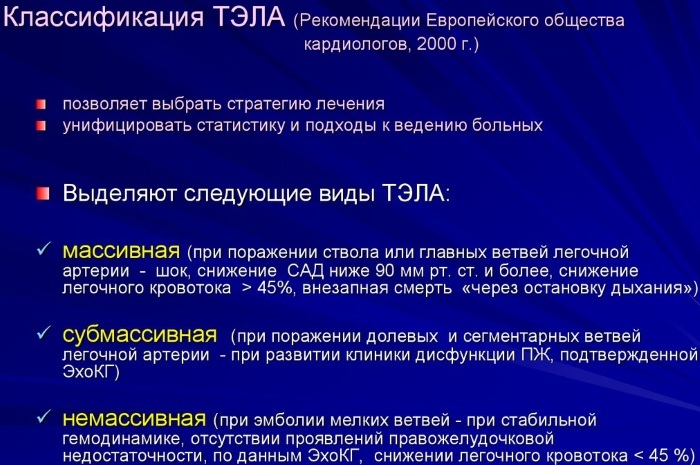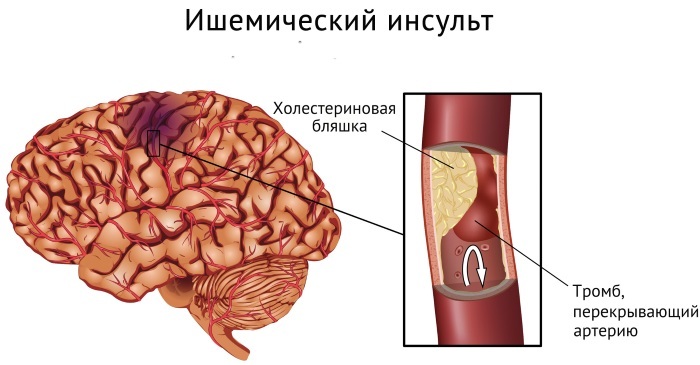Heart rate is a vital indicator of the functioning of the human body. A pulse of 80-110 beats per minute is considered normal at rest. After physical activity or when performing certain movements, the parameters may change.
Sometimes, even at rest, a person has tachycardia. The cause of pathological changes must be determined in a timely manner and treated in order to prevent serious complications.
Record content:
- 1 What determines the frequency of heartbeat in a person?
- 2 Heart rate by age during sleep, at rest, when walking, running, training
- 3 How to measure your heart rate correctly?
- 4 Symptoms of a malfunctioning heart rate
- 5 Natural causes of tachycardia in humans
- 6 Causes of bradycardia
- 7 Diseases accompanied by a frequent and low pulse
- 8 Diagnosis of heart rate disorders
-
9 Treatment methods and principles of heart rate normalization
- 9.1 Drug therapy
- 9.2 Folk remedies
- 9.3 Diet
- 10 Human pulse video
What determines the frequency of heartbeat in a person?
The heart rate during the day can change due to many factors. It can be not only physical activity, but also stress, emotional outbursts. The impact of external factors.
In most cases, heart rate parameters depend on age-related changes that occur in the human body. In children, the increased rates are explained by intensive growth. Teenagers face tachycardia more often due to puberty or with vegetative dystonia. The same goes for stress and anxiety at school, at home.
The heart rate in the elderly is determined depending on the wear and tear of the body. As it ages, the risk of developing numerous diseases that are accompanied by tachycardia or bradycardia increases. An increase in heart rate occurs even at rest, not to mention physical activity.
Heart rate by age during sleep, at rest, when walking, running, training
Accurate heart rate readings can be obtained in the morning. It is not recommended to take measurements in the evening, the results are distorted after a day. The rate of indicators often depends on age. If there are no accompanying signs and the pressure is within acceptable limits, the likelihood of the development of pathological processes is low.

The rate of heart rate depending on the age of the person:
| Age (years) | Minimum-Maximum | Average indicators |
| 15-50 | 60-80 | 70 |
| 50-70 | 66-87 | 76 |
| 70 and above | 72-92 | 81 |
In children, heart rate also changes with age up to 15 years:
| Age | Minimum-Maximum | Average indicators |
| 3-4 weeks | 115-165 | 135 |
| 1-12 months | 105-160 | 130 |
| 1-3 years | 90-150 | 122 |
| 3-5 years | 85-135 | 110 |
| 5-7 years | 80-120 | 100 |
| 7-9 years old | 72-112 | 92 |
| 9-11 years old | 65-105 | 85 |
| 11-15 years old | 58-97 | 77 |
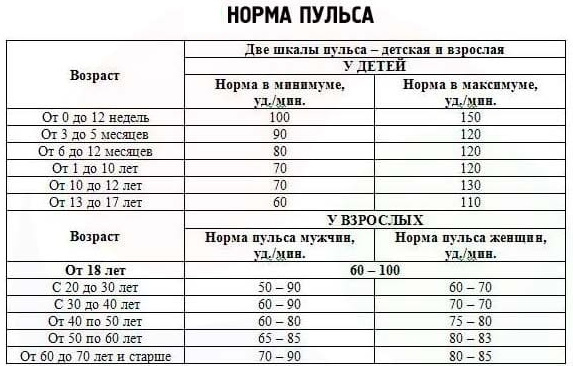
There are also certain statistics, taking into account the state of a person when walking, running or during physical exertion, at rest:
| Name | Age (years) | Heart rate |
| At the moment of walking | 15 | 165 |
| 35 | 145 | |
| 55 | 125 | |
| 75 | 105 | |
| At rest | Adults | 60-80 |
| Elderly | 70-90 | |
| Teenagers | 70-80 | |
| Children under 2 years old | 90-100 | |
| Newborn | 130-140 | |
| While running | 30 | 110-170 |
| 50 | 90-150 | |
| 70 | 70-130 | |
| Pregnancy | 1 trimester | 70-90 |
| 2 trimester | 80-100 | |
| 3 trimester | 70-100 |
Any deviations from the established norm that have been observed for a long time require urgent consultation with a cardiologist and a comprehensive examination. This is especially true for women during the period of bearing a child.
How to measure your heart rate correctly?
A pulse of 90-100 beats per minute is normal when a person is healthy.
Heart rate can be measured in several ways:
- On the inside of the wrist under the thumb. The radial artery is located in this area.
- In the area of the temples. The temporal artery is located in this part of the body.
- Under the knee. This area contains the popliteal artery.
- At the fold where the pelvis and lower limb join. The femoral artery passes here.
- On the inside of the elbow. The brachial artery runs through this part of the body.
- On the neck on the right side under the jaw, where the carotid artery is located.
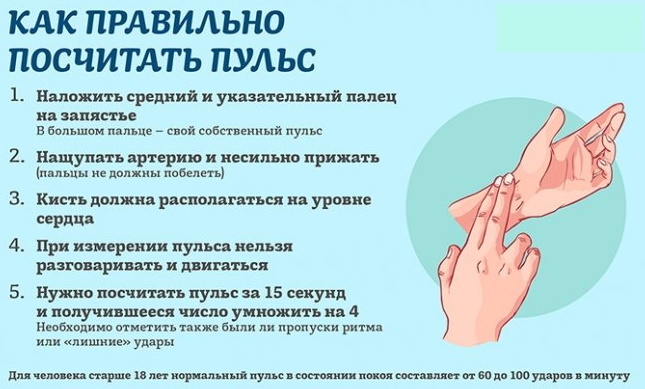 In most cases, heart rate is measured in the area of the wrist where the radial artery passes. This is because the vessel is close to the surface of the skin. You need to find a pulsating vein, put three fingers and press well. At the same time, look at the clock and count how many beats per minute the heart gives out.
In most cases, heart rate is measured in the area of the wrist where the radial artery passes. This is because the vessel is close to the surface of the skin. You need to find a pulsating vein, put three fingers and press well. At the same time, look at the clock and count how many beats per minute the heart gives out.
Symptoms of a malfunctioning heart rate
The clinical picture with tachycardia or bradycardia will help the doctor establish a preliminary diagnosis and prescribe an informative examination for the patient. You should not delay going to a specialist, even minor deviations may indicate the development of a serious pathology.
| Name | Symptoms |
| Tachycardia |
|
| Bradycardia |
|
It is not worthwhile to carry out treatment on your own without an established diagnosis. There is a risk of worsening health and an increased likelihood of complications.
Natural causes of tachycardia in humans
A pulse above 110 beats per minute is tachycardia, which is a pathological condition and occurs against a background of numerous reasons. In such a situation, a person cannot feel normal, discomfort arises.
There are numerous factors that trigger change:
| Name | Causes |
| Physiological |
|
| Pathological |
|
Physiological factors provoke a temporary increase in heart rate. When the cause is eliminated, the person's condition stabilizes on its own. Pathological factors are diseases, against the background of which the pulse becomes more frequent. In this situation, it is impossible to do without comprehensive diagnostics and correctly selected therapy.
Causes of bradycardia
A decrease in heart rate in medicine is called bradycardia. The condition also occurs against the background of numerous provoking reasons.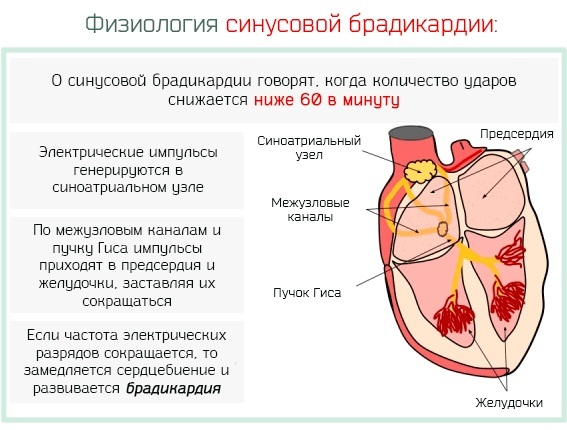
| Name | Description |
| Physiological causes |
|
| Pathological |
|
Pathological changes are accompanied by characteristic clinical symptoms, with which it is necessary to go to the hospital. A comprehensive examination will determine the main factor of low heart rate and select the most effective treatment.
Diseases accompanied by a frequent and low pulse
A weak pulse in adults is provoked by the following pathological processes:
- stomach ulcer;
- hypothyroidism against the background of iodine deficiency;
- meningitis, encephalitis;
- high intracranial pressure against the background of a malignant tumor, cerebral edema or severe bleeding;
- coronary heart disease.
 Frequent and low heart rate also provokes weakness of the heart muscle, autoimmune disorders, and vegetative-vascular dystonia. For patients who are at risk, it is important to always be under the supervision of a specialist and undergo a preventive examination.
Frequent and low heart rate also provokes weakness of the heart muscle, autoimmune disorders, and vegetative-vascular dystonia. For patients who are at risk, it is important to always be under the supervision of a specialist and undergo a preventive examination.
Diagnosis of heart rate disorders
The diagnosis and treatment of tachycardia or bradycardia is carried out by a cardiologist. First of all, a person visits a therapist who prescribes an examination and, based on the results, recommends a consultation with a cardiologist. A pulse rate of 110 beats per minute is normal for a healthy person.
When changing the standard indicators, it is recommended to undergo the following diagnostic measures:
| Name | Description |
| Electroca-radiography | A diagnostic method that allows you to identify arrhythmia and the degree of its development.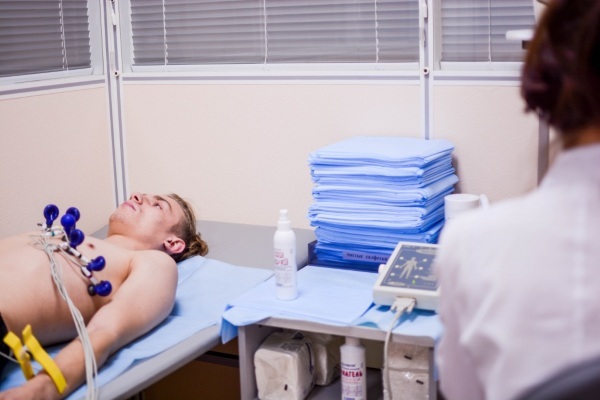
|
| Echocardiography | The study helps to assess heart rhythms, the state of myocardial tissues. |
| General and biochemical blood test | According to the results, the cardiologist will reveal the development of the inflammatory process, against the background of which the work of the heart is disrupted. Biochemistry allows you to evaluate the work of internal organs. |
| Ultrasound examination (ultrasound) | The heart is examined, a specialist examines the structure of the organ, its departments and identifies pathological changes. |
It is important to establish the cause of changes in the heart rate, to differentiate the disease, since many pathologies occur with the same clinical symptoms. Based on the results of the examination, a cardiologist or therapist may prescribe a consultation with other specialized specialists.
Treatment methods and principles of heart rate normalization
Treatment for tachycardia or bradycardia is carried out by complex methods, but strictly under the supervision of a cardiologist. Independent actions are categorically excluded, especially if there is a history of a serious illness. It is necessary to adhere to the prescriptions of the attending physician in order to prevent serious complications.
Drug therapy
Medicines should be taken strictly, following the instructions of a specialist. Violation of the recommendations threatens a person with side effects and serious consequences.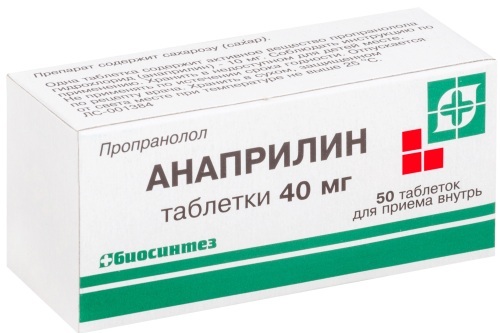
| Drug group | Name | Application |
| Sedatives | Diazepam, Persen | The dosage of the drug depends on the patient's diagnosis and is 2.5-10 mg 2-4 times a day. |
| Beta-blockers | Concor, Anaprilin | The drugs regulate the effect of hormones on the human body. The tablets should be swallowed whole and washed down with water in the morning on an empty stomach. A single adult dosage is 2.5-5 mg. |
| Calcium channel blockers | Verapamil, Amlodipine | The standard dosage of the drug for an adult is 80 mg 3 times a day. The course of treatment continues for 7 days. |
| Potassium channel blockers | Cordaron, Sotalol | The medicine should be taken before meals. The adult standard dose is 600-800 mg per day for 5-8 days. |
| Cardiac glycosides | Digoxin, Digitalis | The tablets are swallowed whole, not chewed and washed down with a sufficient amount of liquid. Adults are prescribed 0.5-1 mg at the first dose, then 0.25-0.75 mg every 6 hours. The treatment lasts 2-3 days. |
| Antiplatelet agents | Aspirin Cardio | The medicine should be taken every 1-2 days for 0.1-0.3 g. |
Treatment of bradycardia is also carried out with drugs, which are prescribed exclusively by a cardiologist: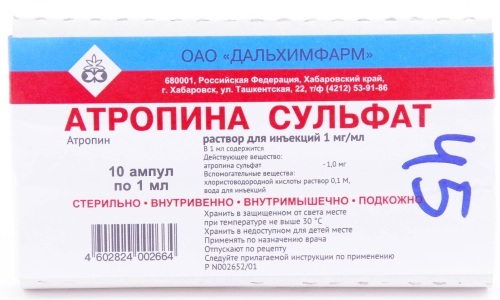
| Drug group | Name | Application |
| Sedatives | Barbamil, Diprazin | The medicine is taken orally or injected intramuscularly. The standard dosage for an adult is 0.025 g 2-3 times a day. |
| Vitamin remedies | Pyridoxine, Tocopherol | The drug is administered intramuscularly or intravenously. Adults are prescribed 500-100 mg 1-2 times a day. The course of therapy lasts 3-4 weeks. |
| Magnesium preparations | Panangin, Asparkan | Dragee is taken orally 1-2 pcs. 3 times a day. The standard treatment lasts 3 weeks, then the doctor adjusts the course of therapy. |
| M-anticholinergics | Atropine, Ipratropium | The drug is taken orally, washed down with water. Patients are prescribed 0.25-1 mg 1-2 times a day. If necessary, the drug is administered intramuscularly or intravenously. |
| Beta-adrenomimetics | Izadrin, Alupent | The medicine is administered intravenously through a dropper. Before use, the drug is dissolved with glucose (5%). The standard dosage is 0.5-5 mcg per minute. |
| Sympathomimetics | Ephedrine, Adrenaline | The drug is injected under the skin or intramuscularly at a dosage of 0.02-0.05 g 2-3 times a day. |
In addition, a cardiologist prescribes biologically active additives (Coenzyme Q10) for a patient with arrhythmia.
Folk remedies
A pulse of 95-100 beats per minute is normal for a calm state of a person. When it rises, complex therapy is needed, depending on the provoking factor.
Non-traditional methods of treating cardiac arrhythmias require the consultation of a cardiologist. It is impossible to take medications on your own, so as not to aggravate the state of health. Natural components are safe for the human body, but there is always the likelihood of an allergic reaction or individual sensitivity.
Effective folk remedies:
| Name | Recipe | Application |
| Vitamin Blend | Mix in equal proportions walnuts, dried apricots and light raisins (400 g each). Grind all components with a meat grinder. Add lemon, pre-cut and natural May honey (7 tablespoons). The finished mass must be insisted for 3 hours, stored in the refrigerator. | In case of violation of the heart rate, patients are advised to use a sweet mixture of 1 tbsp. 2 times a day (morning and evening). |
| Rose hip | Brew 2 tablespoons. berries of a plant with boiling water (1 tbsp.). Insist 1 hour and strain. | Rosehip strengthens the heart muscle, restores the functioning of the cardiovascular system. The finished medicine is recommended to be consumed 1 hour before meals. |
| Black radish | Grind the product, squeeze out the juice and mix it with natural honey in equal parts. | The finished product is recommended to be taken orally 15 ml 3 times a day before meals. The treatment lasts 3 weeks. |
In the fight against arrhythmia, you can use a green apple and onions. The components are ground and mixed in equal parts. It is recommended to take the medicine in the morning and in the evening. For taste, you can add a little natural honey. The course of therapy lasts a month. After a short break, therapy should be continued.
Diet
A pulse of 100-110 beats per minute is normal for active people with an active lifestyle. If the heart rhythm is disturbed, a person needs not only drug treatment, it is important to adhere to a diet. It is necessary to add to the diet foods that contain trace elements that support the work of the heart.
| Featured Products | Prohibited foods |
|
|
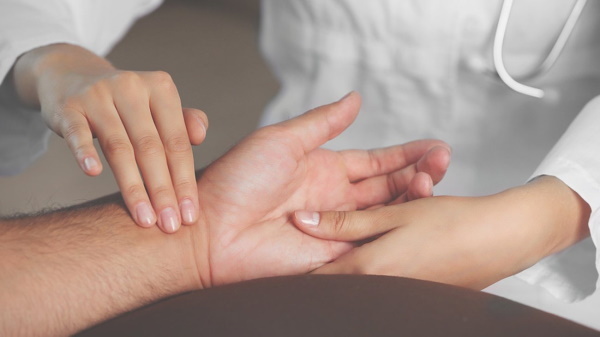
Patients need to eat in small portions 3-4 times a day. Dishes should be warm, while eating, it is not advisable to be distracted. It is important to chew your food thoroughly.
Heart rate indicators for each human body are individual. But at rest, the normal heart rate fluctuates between 60-100 beats per minute.
There are minor deviations or extraordinary single contractions. Long-term disturbance of the heart rhythm cannot be ignored, it is necessary to undergo examination and treatment if the results confirm the development of pathological processes.
Human pulse video
Which pulse is considered normal and which is hazardous to health:

